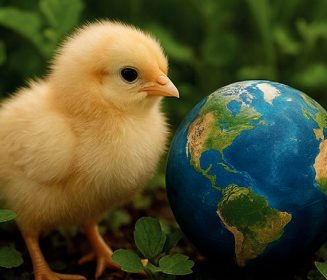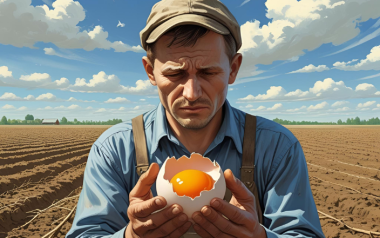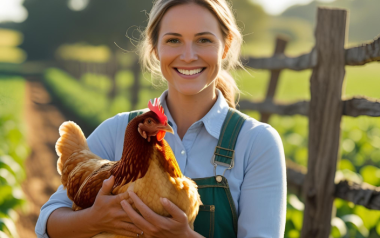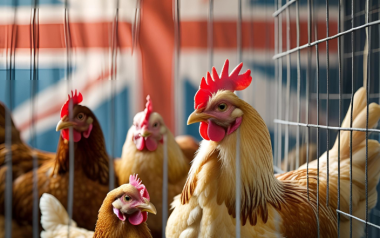08 May 2020
Management of commercial layer operations
Content available at: Español (Spanish) Português (Portuguese (Brazil))“A good productive and profitable laying hen starts with a good quality chick. […]
Content available at:
Español (Spanish) Português (Portuguese (Brazil))
Genetics has been working on an improved laying rate with an emphasis on persistence of production, seeking a balance between:
- Feed consumption
- Body weight
- Egg efficiency and production
- All this accompanied by specific works on internal and external quality of the shell.
As the bird ages, it loses the ability to absorb, metabolize and mobilize nutrients, in addition to decreasing its ability to fix calcium salts and the quality of feathers and their coverage is affected.
The great challenge of today’s genetic houses is to be able to generate a bird that meets the productive and economic needs of the poultry farmer and that is capable of adapting to new production systems, economic index meters and global trends such as animal welfare.
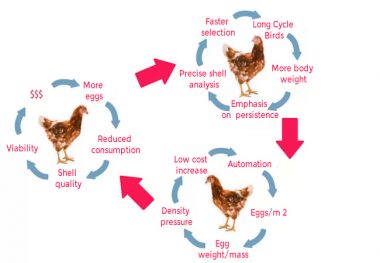
Figure 1. Genetic-industry-economic efficiency interrelation
Chick development
The chick develops according to a sequence of physiological events. Chicks that meet or exceed body weight goals during development stages have a better chance of reaching their genetic potential as layers. Growth interrupted during some of the development phases will result in birds that lack body reserves and organ function to maintain high production as adult layers.

Figure 2. Development of bird systems during growth
0 to 6 WEEKS OF AGE
During this stage, most of the development of the organs of the digestive tract (supply organs) and the immune system occurs. Problems that occur during this period can have negative effects on the function of these systems. Birds stressed during this period may have lifelong difficulties in digesting and absorbing feed nutrients.
Immunosuppression may also result from problems during this period, leaving the bird more susceptible to diseases and less responsive to vaccinations.
6 to 12 WEEKS OF AGE
This is a period of rapid growth and it is when the bird obtains most of the adult structural components – muscles, bones and feathers. Growth deficiencies during this period will prevent the bird from obtaining sufficient bone and muscle reserves, which are necessary to sustain a high level of egg production and to maintain good egg shell quality. 95% of the skeleton is developed at the end of the bird’s 13 weeks of life. At this time the plates of the long bones become calcified and further growth in bone size cannot occur.
Any compensatory growth that occurs after 13 weeks of age will not increase the size of the skeleton. The amount of mineral reserves available for the formation of the eggshell is directly related to the size of the bird’s skeleton. Reactive vaccinations, beak treating, handling, and stressful management practices can delay development during this period of rapid growth.
12-18 WEEKS OF AGE
During this period, the growth rate slows and the reproductive tract matures and prepares for egg production. Muscle development continues and the proliferation of fat cells takes place. Excessive weight gain during this period can result in an excessive amount of abdominal fat.
Low body weight and stressful events at this time can delay the start of egg production. From 7 to 10 days before oviposition of the first egg, the medullary bone that is located within the cavities of the long bones can be increased by feeding the bird a pre-laying ration with higher levels of calcium than the development stage. 
Body weight uniformity
Uniformity of body weights in a flock is as important as reaching the goal of average body weight. The goal of uniformity should be 85% during the growth period (that is, 85% of individual weights should be within 10% of the average). Poor uniformity of body weight hinders correct feeding of the flock, both in the growing period as in lay. Pullets that start the production cycle at different times results in poor uniformity. Birds with a lower than normal weight will produce small eggs.
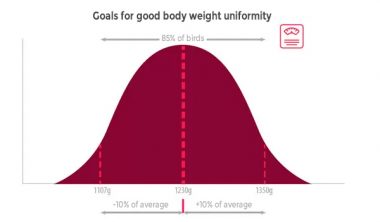

In flocks with poor uniformity, it may be necessary to distribute the birds by weight and then feed them separately. Birds on the floor can be separated into pens by different weight classes. When birds cannot be separated, the flock should be fed according to the requirements of the birds with lower weights.
Monitoring program
A weight monitoring program should be started when the batch is 1 week old.
- During the first 4 weeks, when the birds are still small, weigh random groups of 20 birds.
- After 4 weeks of age, at least 100 birds must be individually weighed per week.
- Continue weighing weekly until birds reach mature body size at 32 weeks of age and then at least every 2 weeks for the remainder of the production period.
For flocks of cage-raised birds, cages of all levels and locations within the house should be selected. All birds within these cages must be weighed separately and the same selected cages must be weighed weekly. Select cages at the beginning and end of feed lines, as well as high and low tiers.
It is preferable to monitor body weight weekly, as this way the producer can quickly identify growth problems allowing corrective actions to be taken on time. Always weigh birds before changing feeding programs, such as changing starter feed to grower feed. Feed changes should always be based on the range of target body weights and not based on flock age.

The development of the breast muscle must be examined, as it is a good indicator that the bird has adequate development and the future productivity of the layer can be predicted. Muscle contains glycogen, a rapidly available source of energy used for egg production. Birds that start egg production with insufficient muscle will not have enough energy available to maintain high egg production.
Decreasing lighting programs:
- Promotes growth
- Determines the age of sexual maturity
- They affect the size and mass of the egg (within the limits of the genetics).
In a typical decreasing lighting program, daylight hours gradually decrease over the first 8 to 12 weeks, providing the growing flock of young birds with additional overtime at feeding time to promote growth.
Age of sexual maturity and egg size are not affected if the decreasing period is 12 weeks or less.
When the declining period extends beyond 12 weeks of age, sexual maturity is delayed and the size of the egg increases.
Longer declining periods of 12 weeks are appropriate in commercial egg markets that require large eggs or in flocks of breeders that want heavier eggs to hatch.
In open houses, artificial lighting programs should supplement the duration of natural daylight. After starting the stepdown program in the first 12 weeks, artificial lights are programmed to the longest daylight duration that the flock will experience during the growing period, limiting the influence that changes in daylight duration would have on the development of the bird and the age at the first egg.
Today’s high production layers almost inevitably reach a state of negative energy balance during peak production. If the layer has an optimal body condition, it will be able to use its body reserves in critical periods and obtain a production curve without ups and downs.
Drop in production at the peak
The drop in production at the peak is a direct consequence of the low consumption of low-weight chicks, which, to complicate matters, is accompanied by a much lower percentage of fat in their carcasses. In order to obtain from it in its productive stage all these attributes must generate conditions of uniformity and weight, which must be achieved through the consumption and intake of nutrients with all the limitations of raw materials.
When feeding, birds behave like granivores and insectivores.
Fine grinding feed
A finely ground feed generates low consumption and low development of the gizzard muscles, limiting the bird’s digestive capacity. The way in which the raw materials are ground and their granulometry has a direct impact on the consumption of the birds. When birds consume diets with fine particles, the gizzard acts more as a food transit organ than as a grinding organ, with the granulometry of the diet being a determining factor in the productive response.
The granulometry in balanced feeds is nothing but the measurement of the size of the particles present in a food and the calculation of the quantity of each one on a predicted scale. Particle size is determined by the average geometric diameter and a measure of dispersion should always be included (Nir et al., 1994).
- Birds have a poorly developed sense of smell and taste (12 taste buds). The beak has mechano-receptors that respond to contact with food, preferring particle sizes that adapt to the size of the beak.
- From an early age, birds tend to eat thick particles with bright colors, regardless of the nutritional composition of the particle.
- The preference for larger particles increases with age. In birds, the mechanoreceptors are more important than the chemical sensors, since they receive feeding signals from visual, tactile and, to a lesser degree, olfactory stimuli. In a feed with a heterogeneous grain size, birds can select large particles, generating nutritional imbalance.
Larger particles have a longer exposure time in the small intestine, causing better use of nutrients
- Mixing quality.
- Pellet quality.
- Use of nutrients by the animal.
- Quantity and quality of intestinal villi.
- The speed of the passage of feed through the digestive tract.
- The Size of the gizzard.
- The Length of the Gastro-Intestinal Tract.
Likewise, the particle size is affected by:
- The type of ingredients used.
- The type of mill used.
- The rotation speed of the mill.
- The size of the sieve.
To obtain the best granulometry, the grinding process is essential, since it is in charge of reducing the particle size as much as possible and making the dispersion as small as possible, increasing the surface area of the ingredients to the action of the enzymes increasing the digestibility of nutrients and facilitating the handling and mixing of raw materials, increasing production efficiency and particle quality.
Careful attention to poultry management principles is critical to the success and best profits of your laying poultry flocks. Growing a flock of birds with the correct weight and body shape will ensure a successful laying period. Problems such as low egg numbers and poor quality of the eggshell during laying are often related to problems that occurred during the growth period.







